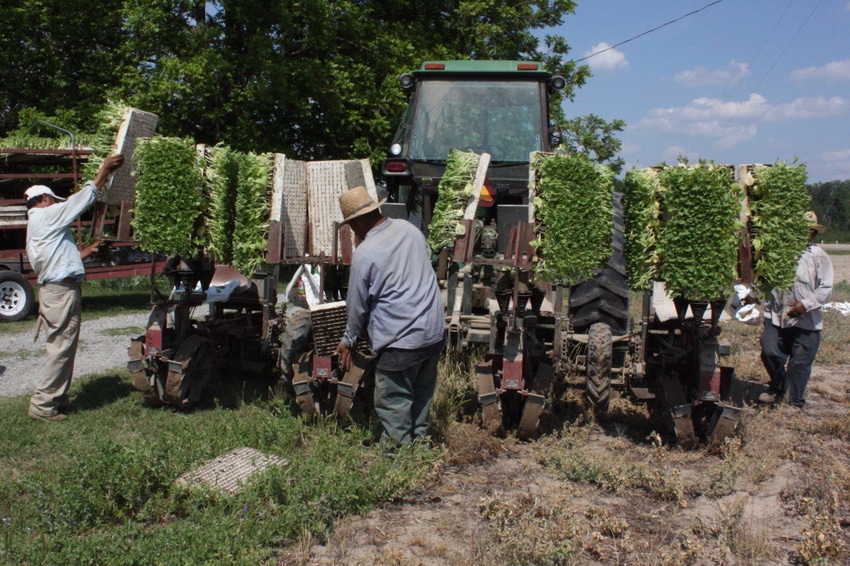May 19, 2014

Even though substantially all tobacco plants in this country are grown in greenhouses for the first 60 days or so of their lives, they can still be vulnerable to cold winter weather.
That is what Jeff Aiken, who grows burley in Tedford, Tenn., was afraid of back on March 8, when he started seeding his greenhouses. His reason for concern: there were extreme temperature changes during and after seeding.
"If you get conditions like this, there is a chance you will have problems of germination,”he says. "We tried to avoid wide variations in the temperature inside the greenhouse," but he wasn't entirely able.
But at the beginning of May, just before he began setting plants out in the field, the quality of the plants was good, and there were no diseases. Germination had been good.
But there was one potential problem—the weather had delayed the plants’development, he said. "They may be 10 days behind schedule to be ready to transplant."
Farmers throughout the Tobacco Belt had similar experiences, but there was optimism about how things would turn out. Tobacco is a plant that can catch up quickly in the field if conditions are favorable and make up for a delayed start. But if weather extremes were to continue through the field season, the plants might fall further behind, possibly interfering with the harvest.
Transplants were a bit scarce in the dark air-cured and fire-cured area of north central Tennessee and western Kentucky, said Andy Bailey, Kentucky-Tennesee Extension dark tobacco specialist.
"Some greenhouse operators waited five to 10 days later than normal to seed because of the price of LP gas," he said. "Since then we have had a lot of cold nights and cool days. Now we are probably a week behind overall on seeding date and another week behind in growth in the greenhouse."
That has lead to a few problems already and could lead to more.
Plant shortage?
In the North Carolina Piedmont and Coastal plain, it was a hard season for flue-cured plant production too, with the cold and with more cloudy days than usual. "The supply of plants is a little tight, maybe five or 10 percent short of what was planned," said Matthew Vann, N.C. Extension tobacco specialist.
In Johnston County, N.C., south of Raleigh in the Coastal Plain, farmers had reasonable success in the greenhouse. "I would say we are four to 5 percent down in useable transplants compared to a normal year," said Bryant Spivey, county Extension director. "But the plants we have are very healthy, and I believe the supply is adequate, but it is close."
Another possibility: the cool temperatures may result in more premature flowering and ground suckers in the field, he said.
Even though the season was running late, some North Carolina growers delayed transplanting a little longer in hopes of warmer temperatures and dryer soils.
"You might say the crop is a week or two behind," said Vann. "But that certainly isn't anything to worry about in this state, especially in the east where we have such a large planting window. From Winston-Salem west (the Piedmont), there might be a little more concern."
In the Pee Dee of eastern South Carolina, farmers were still setting in early May, but most fields have been set, said William Hardee, area Extension agronomy agent in Conway, S.C. "Nearly all our fields got off to a late start. I think everyone will get enough plants, but there will be few left over."
Deep South transplanting
Transplanting in Georgia will likely continue until close to May 15, said J. Michael Moore, Georgia/Florida Extension tobacco specialist. "In addition to the cultivation and fertilization which is needed now, growers must manage weed and insect pests which may occur in the early production season," he said.
Farmers ran into one problem this plant-producing season. Sometimes they had to clip and hold plants they had already treated with Actigard to reduce TSWV.
"Treated plants are best used seven days after treatment," said Moore. "Holding Actigard-activated plants in the greenhouse longer than seven days begins to eat into the window of control expected once they are taken to the field."
Transplanting was complete in Florida by May 1, and some farmers are well along in cultivation, Moore said.
In other tobacco news:
A popular fertilizer product is coming back on the market after a long absence. SQM is reintroducing what was formerly called Soda Potash 15-0-14, which hadn't been marketed since 2003. It will now be called Sodium Potassium Nitrate and will now have an analysis of 15-0-15. As in the past, its nitrogen will be 100-percent nitrate nitrogen, and its potassium is chlorine free. Supplies for this season will be limited, said a representative of the manufacturer, Yara North America.
Liquid nicotine for e-cigarettes is now being produced on a commercial scale in the United States by USA Liquid Nicotine, which has extraction facilities in Albany, Ga., and buying and marketing offices in Harrisburg, Ky.
Managing partner Brian Furnish, a farmer who served several years as general manager of Burley Tobacco Growers Cooperative Association in Lexington, Ky., says the company is selling pure liquid nicotine extracted from burley acquired in Kentucky.
So far, Furnish says they have only used air-cured leaf, mainly burley, because of its higher nicotine content relative to flue-cured and other types.
Individual leaves are stripped from cured stalks and collected for the extraction process. Eventually, a production scheme will be worked out for e-cig tobacco. Furnish said it will involve changes in variety choice, fertility programs and timing of topping and suckering.
About the Author(s)
You May Also Like




